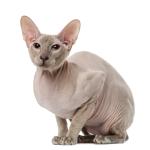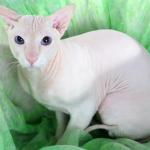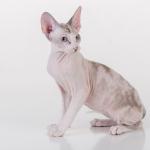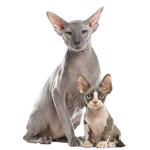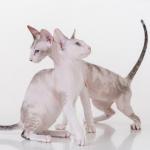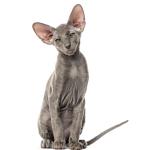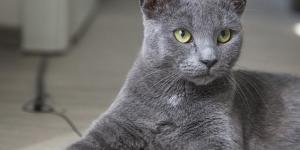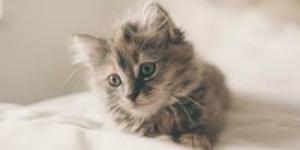Peterbald Cat
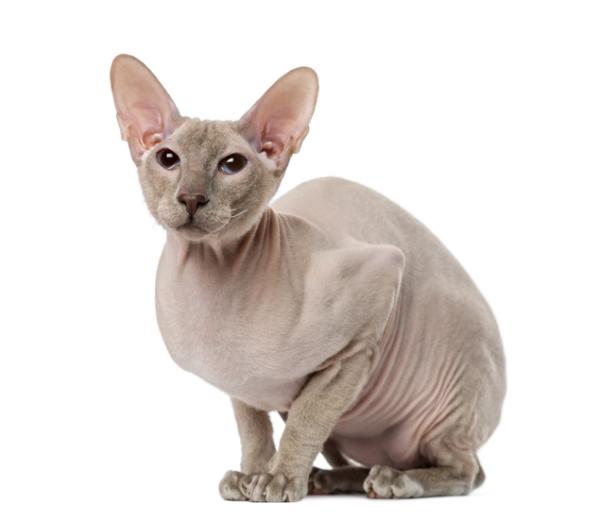
The Peterbald is one of the so-called hairless cat breeds, although this is not always the case (see more below). They are essentially the ‘oriental version’ of the more common Sphynx cat breed, since they were created by crossing this breed with others. In addition to their striking appearance, these cats are renowned for their affectionate and caring nature. In fact, some believe them to behave more like a dog than a cat. For these reasons and more, the Peterbald cat breed has grown into being one of the finest feline companions a person can have.
Do you want to know everything about the Peterbald cat breed? If so, keep reading. AnimalWised brings you the origin, characteristics, care and health information you need if you are thinking about adopting this unique cat breed into the family.
- Europe
- Russia
- Category IV
- 7-11
- 11-13
- 13-17
- 17-22
- 22-30
- 8-10
- 10-15
- 15-18
- 18-20
Origin of the Peterbald cat
Peterbald cats are originally from Russia where, in the 1990's, Oriental Shorthair cats were bred with Siamese cats and a certain breed of Sphynx cat. The reason for this cross was the intention to create a hairless cat like the Sphynx, but with an oriental morphology. The Peterbald's name comes from its city of origin, Saint Petersburg, and the fact it is hairless.
It did not take long after the initial 1994 crossing to create a distinctive breed with a unique appearance and lovable personality. They were officially recognized by The International Cat Association (TICA) only three years later in 1997. the world Cat Federation followed suit in 2003.
Physical characteristics of the Peterbald cat
The Peterbald is a cat of medium body size and has a stylized shape. This desirable appearance is characterized by their very long legs and similarly lithe tail. Despite their sleek shape, they are quite robust and resistant. Their weight ranges from 3 to 5 kilos and they have a life expectancy of around 12 to 16 years.
Looking at the other characteristics of the Peterbald cat, we can see they have a thin head shape which is proportionate to the rest of their body. They have large triangular ears and a thin long nose. Framed by its elegant face, the Peterbald cat's eyes are medium sized and not pronounced like some cat breeds. They are a beautiful almond shape and have colors which match their skin color.
Although this cat breed is considered hairless, not all Peterbalds are completely bald. Some have a very short coat which never exceeds 5 mm in length. Some may be born with a certain amount of hair which is completely shed as they age and develop. Their markings and hair color (if applicable) can come in almost any color and pattern.
Character of the Peterbald cat
Usually very affectionate and with an even-temperament, the Peterbald cat is most often a darling of a cat. They love to spend time in the company of humans and be pampered when possible. They are very sociable cats which will require frequent interaction with people.
Because of this sociable nature, the Peterbald gets along well with other cats, children and even dogs. In addition, they can adapt easily to various home environments, including apartments. They reputation as a cat with a canine sensibility stems from their desire to follow their human family around and they can even engage in play like a dog. Some Peterbald guardians have been known to take their cats out on a leash for walks.
Due to their patience and balanced character, the Peterbald is an ideal cat for children, so long as both are educated and well-socialized. With the right level of care and respect, they can be ideal companions for each other.
Peterbald cat care
Due to the peculiarities of their fur, or lack thereof, keeping them in healthy condition is relatively simple. They will not need the regular brushing of other cat breeds, such as Persian longhair cats. There is a catch, however. Since the Peterbald does not have any fur, they do not have a means of collecting the natural oils which are secreted through their skin. While they will perform acts of self-grooming, they will need to be bathed once a week to get rid of the accumulate oils, encourage hygiene and prevent body odor. If a bath is not feasible every week, special wipes can be used to removed dirt. You may want to use special moisturizing creams, but ensure they are non-toxic to cats. If you need some more info, this article on how to bathe hairless cats may be useful.
Although caring for the Peterbald can be relatively simple, there are some specific considerations we need to make. They are very sensitive to both cold and heat. In cold weather conditions, they should not be allowed outside and may need to wear special cat clothes to keep them protected from cold temperatures. In the hot sun, their hairless skin is much more susceptible to sun damage. If they do have access to the outside on sunny days or are in sunlight a lot, then we will need to apply feline sunscreen to prevent certain problems such as skin cancer.
In terms of behavior, their affectionate nature means they need regular interaction. Daily, we need to dedicate the time to engage with them in play activity and simply spend time with them. Environmental enrichment in the form of toys, intelligence games and, ideally, scratching trees and other places to climb. If a Peterbald does have to spend time on their own, then it is essential they have another playmate whether in the form of other cats or different animals.
Cat health peterbald
The Peterbald cat breed is, generally, very healthy and strong. They do not need as much careful attention as some breeds, but this does not mean there are not steps we can take to ensure their health. We need to ensure they are properly vaccinated and dewormed. When we do bathe them, we need to be careful to monitor their skin. Just because they don't have fur, doesn't mean they cannot get parasitical infestations. We will also need to provide a skin care routine to keep it soft and protected.
As the Peterbald is such a relatively new breed, there are few genetically inherited problems we need to be wary of. This is, of course, apart from looking after their skin. As they have such large ears, it is important we monitor their condition, in particular for signs of mites. You will need to trim their claws every once in a while and older cats will likely need their anal glands expressed from time to time.
- Peterbald - Fédération Internationale Féline.
- Peterbald - World Cat Federation.
- Peterbald - The International Cat Association
Peterbald Cat photos
